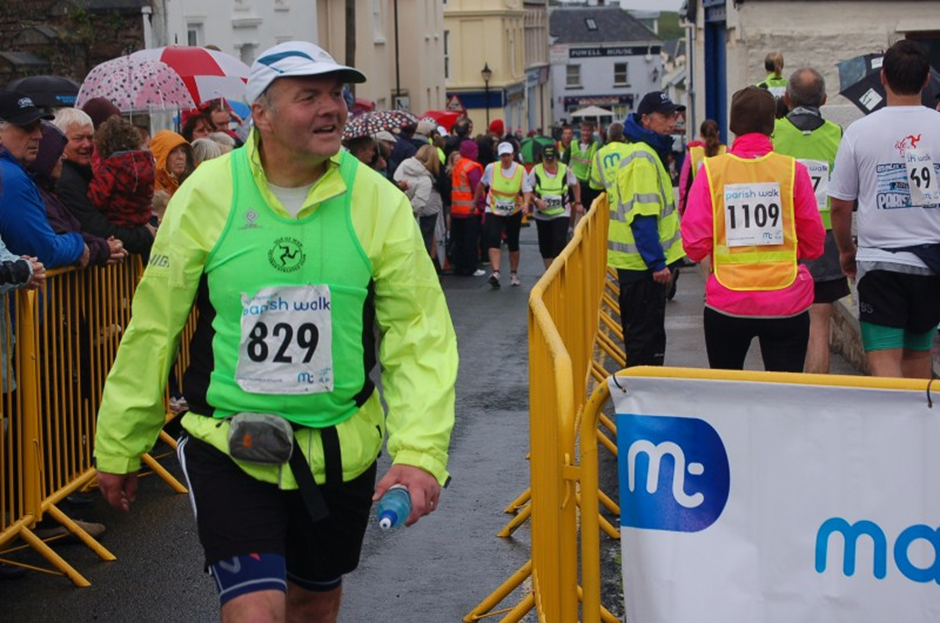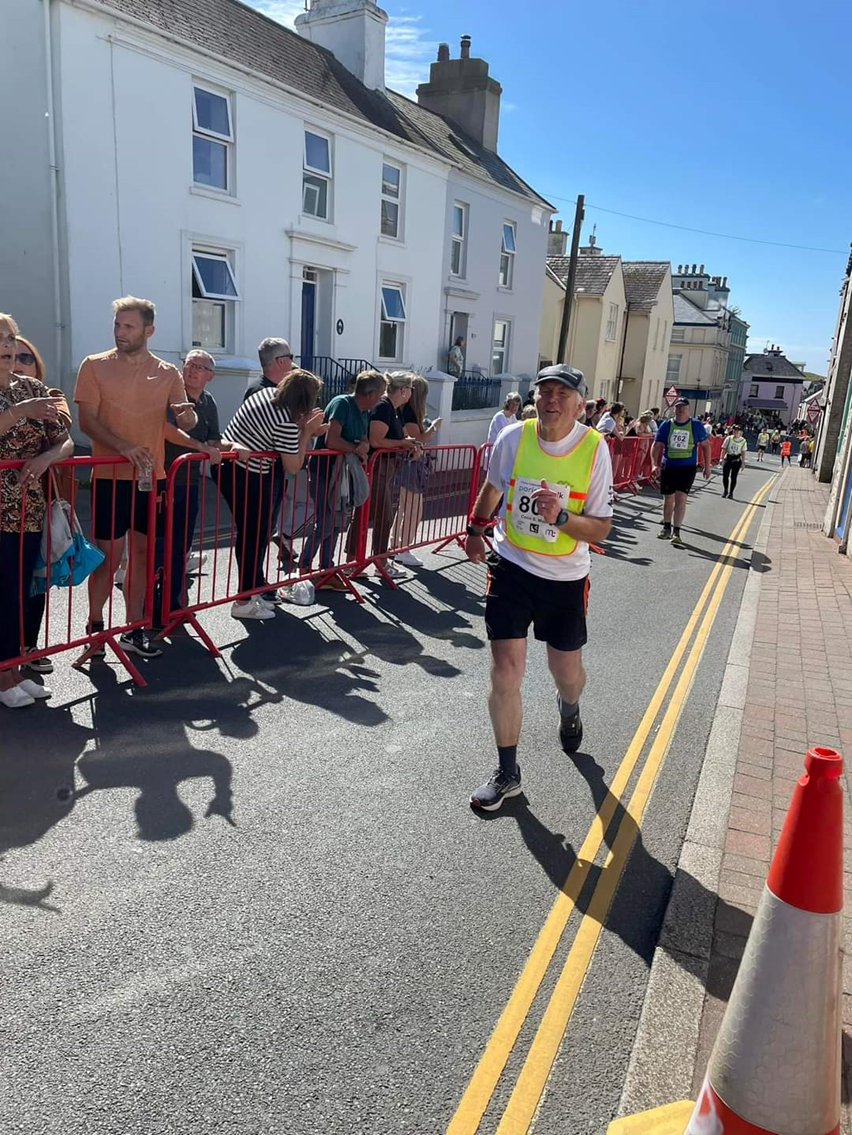LONG ROAD
OUT OF EDEN – JURBY (PART SEVEN)
Now the dust is settling (literally)
from an exciting T.T. fortnight, it is time to turn our collective attentions
to the ‘P. W.’, the event being now only 10 days distant. Training should be
starting to taper off now, and personally I have one more six miles night walk
and an eleven miles circuit of Maughold planned before the end of the weekend.
A sortie up from Rushen to the
Round Table and back last weekend brought up my mileage total so far to just
over my planned 300 miles. However, this figure barely registers compared to
some of the figures being recorded on Strava by those training solo like Paulo
Atherton and Dean Morgan, or the regular group containing Richard Gerrard, James
Quirk, David Walker, Josh Knights et al.
This all points to a fascinating
battle at the front of the field, which looks
to contain no less than eight of last year’s top ten (unless Liam Parker or
Patrick Bregazzi turns out to be Raymond the Raven…). No less a battle for
supremacy is expected in the Women’s Race, with the recent posting by last year’s
winner and fellow blogger Sammy Bowden that her aim this year is to get two
friends from ‘across’ round the full circuit rather than look for personal
glory having opened up the field, which can only benefit the likes of Louise Gimson,
Lorna Gleave and 2018 winner Bernie Johnson.
Unfortunately, I will need to
await the footage on YouTube to see the outcome of the various strategies and tactics,
as once the leaders exit the NSC it will be last I see of them on the day!
The majority of next week should
be spent resting, though keeping supple and getting as good a night’s sleep as
the hot weather and early sun rises allow. The main focus for the last few days
should be to ‘get packing’…
WHAT TO WEAR / PACK
FOR THE DAY
The picture below gives a good
impression as to what many halls across the Island will look like in a week’s
time, and is reproduced courtesy of Anne-Marie Clucas, who will unfortunately be
having to miss this year’s event and is wished well for the surgery pencilled
in for August to enable her to resume her wonderful fund-raising activities in
2024.
I’ve started making a list of items
needed to be worn on the day / packed for later so that there is not a mad
panic on Friday evening! The food variation might look sparce at the moment, though
there will be adequate bananas and mars bars etc available en route, whilst in
recent years I have determined that the slices of orange at Santon and slices
of pineapple (wherever you can locate them) are very refreshing, though sticky
on the hands!
* Either ‘shades’
for ‘cool’ competitors like Andrew Titley and Dick Callin, or alternatively spectacles
for those like myself who would otherwise trip up when it starts getting dark
on the way up to Bride…
** Eddie Convery, who was fourth in the 1980
event regularly advises me that he got round that year on ’16 pints of milk’.
*** Please consider carefully
whether to take aspirin/paracetamol when the ‘going gets tough’, especially in
hot weather. There is much good commentary online, with the overriding advice
being that ‘pain is temporary, kidney damage might be permanent’.
**** The phone
has both positive and negative benefits: It will be useful to let your support
crew know of your requirements before you reach them to save precious time. On
the other hand, it was too handy for me to ring up prematurely from
around Glen Maye In 2016 to tell my backup I was retiring at Peel due to the
heat. If you are bringing a phone, wrap it in a small plastic bag as ,
in the same year’s End to End Walk, I got caught in an absolute deluge going
over the Howe and when I switched on the phone the next morning it was well and
truly deceased…
|
Clothing |
Food & drink |
Electrical |
Additional |
|
|
|
|
|
|
Trainers |
Water |
Watch |
Zinc tape |
|
Socks |
Energy ** drinks |
Head torch |
Vaseline |
|
Base layer trunks |
Energy bars |
Batteries |
Insect repellent |
|
Shorts |
Energy gels |
Lights for back |
Plasters |
|
T-Shirt |
Crisps |
Phone**** |
Blister plasters |
|
Sweat band |
Biscuits |
|
Scissors |
|
Racing vest |
Wine gums |
|
Safety pins |
|
Race number |
|
|
Wet wipes |
|
Cap |
|
|
Bags for rubbish |
|
Race belt |
|
|
Sun cream |
|
Water bottle |
|
|
Cooling spray |
|
|
|
|
Knee support |
|
Leggings |
|
|
Electrolyte tablets |
|
Base layer torso |
|
|
(Sun) glasses * |
|
Rain jacket |
|
|
|
|
Gloves |
|
|
|
|
Woolly hat |
|
|
|
|
Jumper |
|
|
Paracetamol?*** |
ON THE
DAY
The following is taken (with kind
permission from Tim Erickson, Secretary of Australian Centurion Racewalkers)
from their excellent website. It is specific to the 100 miles event, though has
much relevance for our own feat of endurance, although after all these years I
still need someone to explain how the ingestion of x numbers of grammes of
carbohydrate / protein per hour is calculated!
- Judge the pace in the opening hours.
- Keep the action going through the
inevitable bad spots.
- Prevent the pace from dropping
drastically in inclement weather and the unbelievably tiring later stages.
- Eating and drinking play a large part in
success in endurance events and can quickly bring you through the bad
stretches that inevitably hit you. This is discussed in depth further
down.
- Particular care must be taken to use Vaseline
very liberally (for obvious reasons). Spare clothes and shoes (but never
brand-new ones) should always be available, as well as foul-weather gear,
even if the day seems promising when the race starts.
All in all, the ultra-long-distance
aspirant must
- be a good judge of pace.
- not get panicked.
- be able to take a hard jolt and come out
of it.
- never seriously consider the thought of
retirement.
Hints for the actual race
- Make sure that your take precautions
against blisters – tape feet/toes if necessary, etc. Experiment in this
matter beforehand.
- Have your initial pace worked out so that
you are not heading off to fast.
- Do not forgo your race plan in the early
stages when you feel good and want to speed up.
- Have your stops well planned in advance
and take them even if you still feel ok.
- Feed regularly – when you feel the need
for nourishment, it is generally too late already.
- Have changes of shoes, clothes, wet
weather gear, whatever medical gear you might need, plenty of Vaseline or
equivalent, etc.
- Have someone experienced looking after
you and making sure that you adhere to your plan. That person should be
able to calculate what breaks to take, how much time remains, etc. You
might not be in a fit state to make these sorts of decisions for yourself.
- Come into the race with the conviction
that you will finish.
Eating and drinking in the race
Eating and drinking play a large part in success in
endurance events and can quickly bring you through the bad stretches that
inevitably hit you. In races of 24 hours of less, it is better to stick to
highly digestible foods – tinned fruit, high energy drinks, barley sugar, etc.
However, everyone has their own favourite recipe be it Coca Cola or rice
pudding or porridge (yes, seriously, I remember someone who used to have it
during a 50 km event). Warm tea is helpful on warm days and soft drinks should
never be taken too cold. In races of more than 24 hours, more substantial food
is needed in addition to the above. Omelettes, warm soup (with bread mixed in)
and roast chicken are all used successfully in Europe. Obviously that is one
you must work out for yourself through practice.
Now the paragraph above was written many years ago
and sounds rather simplistic nowadays so let’s tease it out a bit.
- You
must carbohydrate load in the last few days leading up to such an event.
Amongst other things, this reduces the probability that hypoglycaemia will
develop during the race. But this alone is not sufficient.
- You
must also eat a pre-race breakfast (e.g., cereal and fruit) In fact, you
should ensure that you ingest adequate carbohydrate in the 12 hours before
the race (i.e., at dinner the night before and at breakfast on the day of
the race). Note that you should practice this before hand – the last thing
you want is to have breakfast when you have not tested it out before and
then get sick during the early hours of the race. But this is still not
enough.
- You
must also ingest carbohydrate during all races of further than 4 hours or
50km. The evidence suggests that the greatest performance benefit is seen
with an ingestion rate of 1gm/kg/hr of carbohydrate (ideally consisting of
glucose: fructose in a 2:1 ratio). So, a 60kg walker should aim for around
60gm/hr of carbohydrate. But this is harder than it sounds as the gut will
not tolerate such high doses of carbohydrate over long race periods unless
it has been trained beforehand – or else you risk the dreaded GI issues
(dizziness, nausea, stomach or intestinal cramps, vomiting and diarrhoea).
- You
must also drink regularly during such an event as it is vitally important
that you avoid dehydration.
So, what to do. I work on a mixture of gels and
drinks and solid food. For gels, I prefer PowerBar PowerGel Sachets
with Caffeine or High5 IsoGel with Caffeine. Both are easy
to take and don’t seem to cause me any issues. For food, I take bananas,
fruit, honey sandwiches, etc. For drinks, I use PowerBar Isoactive
Drink Mix. This comes in powder form, and you mix your own sports drink to
your own satisfaction. Your job is to experiment to see which combination suits
you.
Tim Erickson




Comments
Post a Comment